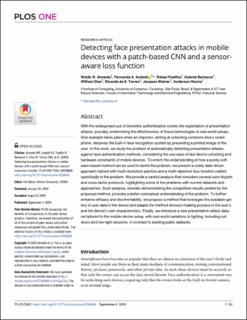| dc.contributor.author | Almeida, Waldir | |
| dc.contributor.author | Andaló, Fernanda | |
| dc.contributor.author | Padilha, Rafael | |
| dc.contributor.author | Bertocco, Gabriel | |
| dc.contributor.author | Dias, William | |
| dc.contributor.author | Torres, Ricardo Da Silva | |
| dc.contributor.author | Wainer, Jacques | |
| dc.contributor.author | Rocha, Anderson | |
| dc.date.accessioned | 2022-05-04T11:49:57Z | |
| dc.date.available | 2022-05-04T11:49:57Z | |
| dc.date.created | 2020-09-12T18:11:20Z | |
| dc.date.issued | 2020 | |
| dc.identifier.citation | PLOS ONE. 2020, 15 (9), . | en_US |
| dc.identifier.issn | 1932-6203 | |
| dc.identifier.uri | https://hdl.handle.net/11250/2994179 | |
| dc.description.abstract | With the widespread use of biometric authentication comes the exploitation of presentation attacks, possibly undermining the effectiveness of these technologies in real-world setups. One example takes place when an impostor, aiming at unlocking someone else’s smartphone, deceives the built-in face recognition system by presenting a printed image of the user. In this work, we study the problem of automatically detecting presentation attacks against face authentication methods, considering the use-case of fast device unlocking and hardware constraints of mobile devices. To enrich the understanding of how a purely software-based method can be used to tackle the problem, we present a solely data-driven approach trained with multi-resolution patches and a multi-objective loss function crafted specifically to the problem. We provide a careful analysis that considers several user-disjoint and cross-factor protocols, highlighting some of the problems with current datasets and approaches. Such analysis, besides demonstrating the competitive results yielded by the proposed method, provides a better conceptual understanding of the problem. To further enhance efficacy and discriminability, we propose a method that leverages the available gallery of user data in the device and adapts the method decision-making process to the user’s and the device’s own characteristics. Finally, we introduce a new presentation-attack dataset tailored to the mobile-device setup, with real-world variations in lighting, including outdoors and low-light sessions, in contrast to existing public datasets. | en_US |
| dc.language.iso | eng | en_US |
| dc.publisher | Public Library of Science | en_US |
| dc.rights | Navngivelse 4.0 Internasjonal | * |
| dc.rights.uri | http://creativecommons.org/licenses/by/4.0/deed.no | * |
| dc.title | Detecting face presentation attacks in mobile devices with a patch-based CNN and a sensor-aware loss function | en_US |
| dc.title.alternative | Detecting face presentation attacks in mobile devices with a patch-based CNN and a sensor-aware loss function | en_US |
| dc.type | Peer reviewed | en_US |
| dc.type | Journal article | en_US |
| dc.description.version | publishedVersion | en_US |
| dc.source.pagenumber | 24 | en_US |
| dc.source.volume | 15 | en_US |
| dc.source.journal | PLOS ONE | en_US |
| dc.source.issue | 9 | en_US |
| dc.identifier.doi | 10.1371/journal.pone.0238058 | |
| dc.identifier.cristin | 1829363 | |
| cristin.ispublished | true | |
| cristin.fulltext | original | |
| cristin.qualitycode | 1 | |

